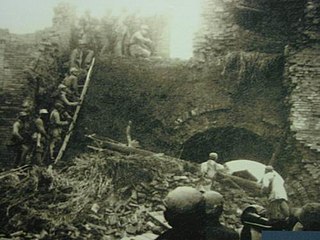
The Shangdang Campaign was a series of battles fought between Eighth Route Army troops led by Liu Bocheng and Kuomintang troops led by Yan Xishan in what is now Shanxi Province, China. The campaign lasted from 10 September 1945, through 12 October 1945. Like all other Chinese Communist victories in the clashes immediately after Imperial Japan's surrender in World War II, the outcome of this campaign altered the course of the peace negotiation held in Chongqing from 28 August 1945, through 11 October 1945, resulting in a more favourable outcome for Mao Zedong and the party.
Longhai Campaign (陇海战役), also known as the Campaign along the Longhai Railway (陇海路战役), was a campaign launched against the nationalists by the communists during Chinese Civil War in the post World War II era. The campaign was a coordinated offensive in support of the other two campaigns the Communists launched against the nationalists, namely, the Campaign of the North China Plain Pocket and the Central Jiangsu Campaign. Longhai Campaign resulted in the communist victory, achieving the Communists objective of relieving the pressure on their comrades in the other two campaigns this one supported, enabling those in the Campaign of the North China Plain Pocket to successfully escape from the nationalists and those in the Central Jiangsu Campaign to also score a huge victory over the nationalists.
The Autumn Offensive of 1947 in Northeast China was a series of battles initiated by the communists against the nationalists during the Chinese Civil War after World War II.
Handan Campaign, also known as Pinghan Campaign (平汉战役), short for Beiping-Hankou Campaign (北平汉口战役), is one of the largest clashes between Communist and Kuomintang (KMT) forces immediately after the end of World War II. It resulted in Communist victory.
The Jingshan–Zhongxiang Campaign was a half-year-long struggle in Hubei between the nationalists and the communists for the control of Jingshan and Zhongxiang regions during the Chinese Civil War; it resulted in communist victory.
The Linfen–Fushan Campaign (临浮战役) was a series of battles fought in regions between Linfen and Floating Mountain in Shanxi, China between the nationalists and the communists during the Chinese Civil War and resulted in communist victory.
Campaign to the North of Baoding consisted of several battles fought between the Nationalists and the Communists in the region north of Baoding during the Chinese Civil War in the post-World War II era and resulted in a Communist victory.
The Campaign to the South of Baoding consisted of several battles fought in regions south of Baoding between the nationalists and the communists during the Chinese Civil War after World War II, and resulted in the communist victory.
The Hebei – Rehe – Chahar Campaign (冀热察战役) was a series of battles fought in Northern China between the nationalists and the communists during the Chinese Civil War in the post World War II era, and resulted in communist victory.
Lüliang campaign (吕梁战役), also called Southwestern Shanxi campaign (晋西南战役), was a series of battles fought between the nationalists and the communists in Lüliang region in southwestern Shanxi during the Chinese Civil War in the post World War II era, and resulted in the communist victory.
Campaign along the Southern Section of the Datong-Puzhou Railway (同蒲路南段战役) was a campaign fought between the nationalists and the communists during the Chinese Civil War in the post-World War II era and resulted in the communist victory.
Datong-Jining Campaign (大同集宁战役) was a series of battles fought between the nationalists and the communists mainly in northern Shanxi and the surrounding regions during the Chinese Civil War in the post-World War II era. The main battlefield was centered on two cities, Datong and Jining.
The Campaign to the North of Daqing River was a series of battles fought between the nationalists and the communists in Hebei, China during the Chinese Civil War in the post-World War II era.

The Taiyuan campaign was a campaign of the Chinese Civil War fought between the nationalist and communist factions. The campaign was over the control of Taiyuan, the capital of the province of Shanxi, China. The campaign resulted in a communist victory.
The Battle of Niangziguan was fought between the communists and the nationalists during the Chinese Civil War in the post World War II era and resulted in communist victory. The battle was a critical one in Zhengtai Campaign that helped to determine the outcome of the campaign.
The Weixian–Guangling–Nuanquan Campaign (蔚广暖战役) was a campaign fought in Wei (蔚) County and Warm Spring of Chahar (province) and Guanling (广灵) of Shanxi, and it was a clash between the communists and the former nationalists turned Japanese puppet regime force who rejoined the nationalists after World War II. The battle was one of the Chinese Civil War in the immediate post World War II era, and resulted in communist victory. This campaign was part of the General Counteroffensive in Shanxi-Chahar (province)-Hebei.
Taixing Campaign (泰兴战役) was a series of battles fought in the Taixing (泰兴) region in central Jiangsu, and was a clash between the Communists and former Nationalists who fought for the Japanese puppet regime and rejoined the Nationalists after World War II. The campaign was part of the Chinese Civil War in the immediate post–World War II era and resulted in a Communist victory.
Datong–Puzhou campaign (同蒲战役) was a campaign that communists fought against the nationalist during the Chinese Civil War in the post-World War II era in Shanxi, and resulted in communist victory.
Western Tai'an Campaign was a series of battles fought between the nationalists and the communists during Chinese Civil War in the post World War II era, and resulted in the communist victory. The communists also refer this campaign as Campaign to Move Eastward, and viewed this campaign as the prelude to Huaihai Campaign.
The Houma Campaign (侯马战役) or Houma Counteroffensive (侯马反击战) was a series of battles fought between the nationalists and the communists during Chinese Civil War in the post World War II era, and resulted in the communist victory.



